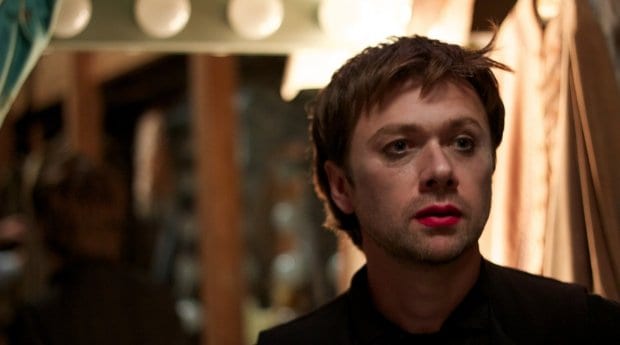When Maxime Desmons first wrote his script for What We Have (Ce Qu’on A) he set in Toronto. But one of the film’s co-producers felt her hometown of North Bay, Ontario would present a better backdrop. The small city plays a not insignificant role in the film, adding a bit of claustrophobia and a sense that everyone’s eyes are on one another in a way that Toronto’s sprawling anonymity never could.
The film of a French émigré named Maurice (played by Desmons himself) reliving his own past through his encounter with a rural Ontario teenager is a sometimes subtle, sometimes blunt encapsulation of how things change and how things remain the same.
The film’s action centres around a francophone theatre group’s staging of Molière’s The Miser, in which Maurice scores the title role after scoring — but screwing up — with the theatre troupe’s underwriter.
Since small town stage acting is not hugely lucrative, Maurice posts signs around town offering French lessons. The first (and apparently only) taker is an ambitious mom whose son Alain becomes a reluctant tutee until he identifies in Maurice a particular kinship. Alain predictably develops an attraction to his teacher.
Desmons tells me in a phone interview that he was in love with most of his own teachers and I am reminded, as I was during my time at university in Montreal, that the French apply the term amour in multiple ways.
But Maurice recoils, not only because of age-appropriateness, we are led to believe, but because of his inability to connect. Above all, Alain needs a friend and Maurice can’t even provide that. There is an inversion at play in the story, with the young Alain the more adult figure.
Desmons was a stage actor in France and has loved The Miser since high school. But while Molière’s play, like the film, features a relationship between an age-variant pair, more relevant is the miser’s chronic inability to connect with other humans, which provides a backdrop to Maurice’s inability to calm his own demons.
Meeting Alain, and witnessing his struggles with loneliness and bullying, sparks flashbacks — fuzzy ones for the audience, presumably far more real for Maurice — to his own youth. If small town suspicion and homophobia are menacing subplots in What We Have, they are abetted by the fact that Maurice always seems to turn up at the pool just when Alain’s teen swim club happens to be practising.
The cycle of abuse is a theme that materializes unexpectedly. Maurice hesitates to get involved in Alain’s life, but when he does it takes the form of a huge overreaction with serious consequences.
“He’s very extreme,” says Desmons of the character he wrote and plays. “He doesn’t know how to temper things.”
A treat in the film is realizing that Alain’s battle-axe grandmother is not driven by pure homophobia.
“The grandmother’s character was very much important for us,” Desmons says. “We wanted to show this character almost as a cliché, then something just snaps and, no, no, no. She’s wiser than we think.”
Desmons, who moved to Toronto from France 12 years ago with minimal English skills, has created a film that is nicely Canadian in its bilingualism. The flow is natural and a unilingual viewer hardly notices the switches.
The film is produced by Damon D’Oliveira, who is married to Desmons, and is fresh off co-producing the CBC miniseries The Book of Negroes.
Desmons met D’Oliveira 12 days after he moved to Canada, but forming a queer CanCon power couple was not what Desmons had in mind.
“I’m not ready for a long-time story,” Desmons recalls his romantic thinking went at the time. “I just need to take care of me and my immigration . . . And here we go.” They’ve been together ever since and were married six years ago.
Both of the film’s screenings at the Vancouver Queer Film Festival will be followed by a Q&A with Desmons and D’Oliveira.
What We Have (Ce Qu’on A)
Friday, Aug 21, 2015 at 6:45pm
SFU Goldcorp Centre for the Arts, 149 W Hastings, Vancouver
Saturday, Aug 22, 2pm
Emily Carr University of Art & Design, 1400 Johnston St on Granville Island, Vancouver
queerfilmfestival.ca

 Why you can trust Xtra
Why you can trust Xtra


